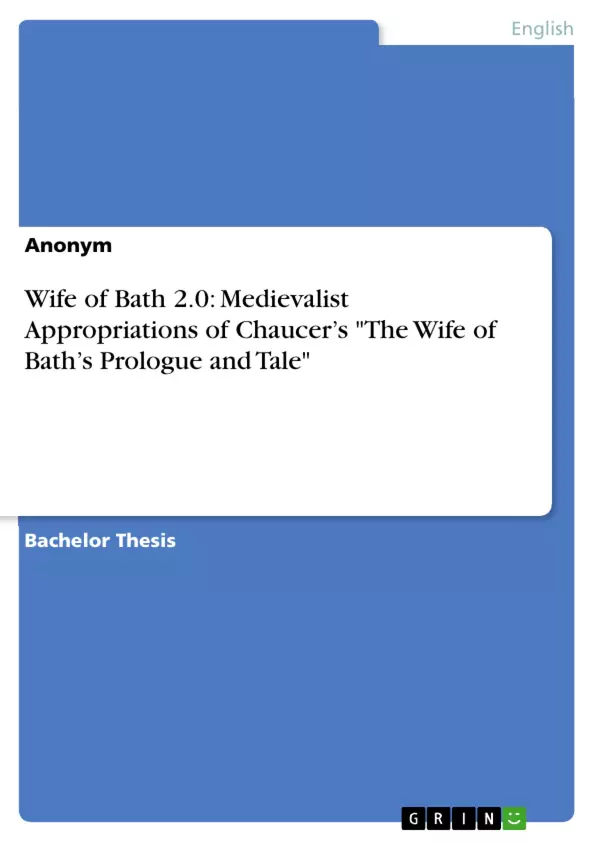A description of what can be regarded as medievalism or neomedievalism will be the focus of the first chapter of this thesis and will be the foundation for the following analysis. The analysis will then focus on Geoffrey Chaucer’s The Wife of Bath’s Prologue and The Wife of Bath’s Tale which is part of The Canterbury Tales. After bringing the basic themes, structure, and linguistic aspects to the surface, these will build the foundation of a comparative analysis of three modern products which adapt Chaucer’s original prologue and tale and reinterpret them in their own way. The three examples in focus will be two poems, the first being Jean “Binta” Breeze’s The Wife of Bath Speaks in Brixton Market, and secondly Patience Agbabi’s What Do Women Like Bes?. The third one is a rap song by Baba Brinkman named The Wife of Bath. All three will be analysed and compared to the original in terms of their content, their structure and language. After the close readings and comparisons, the findings will be revisited in an attempt to recognise a pattern in how they all tried to bring something from the Middle Ages into modern times and see what and why they have changed to achieve this. This chapter will also include reflections on the actuality of the original and the need to refer back to it time and again. Before concluding the thesis, a final evaluation of whether the poems and the song can be regarded as neomedievalism or medievalism will follow to take recourse to the introductory thoughts on these concepts. Thus, the question of research will be how each contemporary medievalist appropriation of Geoffrey Chaucer’s The Wife of Bath’s Prologue and Tale thematises the issues that are implied in Chaucer’s work and in what way they update it for a modern audience to bring forward their message and what they regard as important.
Inhaltsverzeichnis (Table of Contents)
- 1. INTRODUCTION
- 2. THEORETICAL ASPECTS: MEDIEVALISM AND NEOMEDIEVALISM
- 3. CHAUCER: WIFE OF BATH PROLOGUE AND TALE
- 3.1. SUMMARY AND GENERAL THEMES
- 3.2. HISTORICAL CONTEXT
- 4. COMPARATIVE ANALYSIS
- 4.1. JEAN “BINTA” BREEZE – “THE WIFE OF BATH SPEAKS IN BRIXTON MARKET”
- 4.1.1. Summary
- 4.1.2. Analysis
- 4.2. PATIENCE AGBABI - WHAT DO WOMEN LIKE BES?
- 4.2.1. Summary
- 4.2.2. Analysis
- 4.3. BABA BRINKMAN - THE WIFE OF BATH
- 4.3.1. Summary
- 4.3.2. Analysis
- 4.1. JEAN “BINTA” BREEZE – “THE WIFE OF BATH SPEAKS IN BRIXTON MARKET”
- 5. IS THERE A PATTERN?
- 5.1. PATTERN FOR THE ADAPTATION OF THEMES AND THE PLOT
- 5.2. PATTERN FOR THE ADAPTATION OF LANGUAGE
- 6. MEDIEVALISM OR NEOMEDIEVALISM?
- 7. CONCLUSION
Zielsetzung und Themenschwerpunkte (Objectives and Key Themes)
This thesis analyzes how contemporary artists reinterpret Geoffrey Chaucer's The Wife of Bath's Prologue and Tale. It examines the concepts of medievalism and neomedievalism, providing a framework for understanding the approaches taken by modern creators. The analysis focuses on three specific adaptations: poems by Jean “Binta” Breeze and Patience Agbabi, and a rap song by Baba Brinkman. The study aims to identify patterns in their thematic adaptations, plot restructuring, and language choices, ultimately determining whether these works represent medievalism or neomedievalism.
- Medievalism and Neomedievalism as theoretical frameworks
- Thematic adaptations in contemporary retellings of The Wife of Bath's Prologue and Tale
- Analysis of the language and structure employed in modern adaptations
- Identification of patterns in the appropriation of Chaucer's work
- Distinguishing between medievalism and neomedievalism in the selected works
Zusammenfassung der Kapitel (Chapter Summaries)
Chapter 1: Introduction introduces the topic, outlining the thesis's objective to analyze modern adaptations of Chaucer's Wife of Bath and their relation to medievalism and neomedievalism. Chapter 2: Theoretical Aspects: Medievalism and Neomedievalism defines and differentiates the concepts of medievalism and neomedievalism, providing a theoretical foundation for the subsequent analysis. Chapter 3: Chaucer: Wife of Bath Prologue and Tale offers a summary and overview of Chaucer's original work, highlighting its key themes and historical context. Chapter 4: Comparative Analysis provides summaries and analyses of three modern adaptations, examining their approaches to thematic and structural reinterpretation. Chapter 5: Is There a Pattern? explores patterns found in the adaptations across thematic and linguistic elements.
Schlüsselwörter (Keywords)
Medievalism, Neomedievalism, Geoffrey Chaucer, The Wife of Bath's Prologue and Tale, Jean “Binta” Breeze, Patience Agbabi, Baba Brinkman, The Canterbury Tales, Adaptation, Reinterpretation, Literary Analysis, Modern Appropriations.
- Arbeit zitieren
- Anonym (Autor:in), Wife of Bath 2.0: Medievalist Appropriations of Chaucer’s "The Wife of Bath’s Prologue and Tale", München, GRIN Verlag, https://www.grin.com/document/1504545



